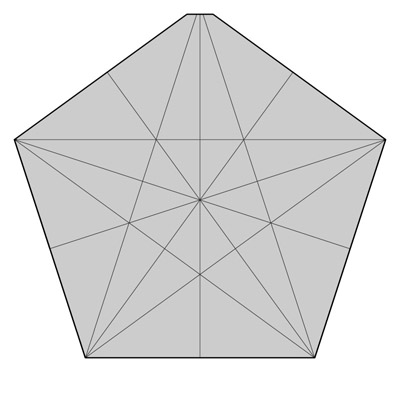I’ve been working on an origami e-book that is on track to come out this spring. (More on that in a future post.) One of the models in it is my Fivefold Rose, which I’ve updated and improved. It’s based on a pentagon and the question of how to fold a regular pentagon from a square has been an age-old problem in origami. I know a few methods for approximating a regular pentagon, and with practice I’ve gotten good at eyeballing it so it comes out every time.
I recently discovered a new method in an old book from Japan from the 60’s. It’s been on my shelf for years, and I was on the verge of throwing it away and thought I’d flip thru it to see if there was anything worth saving it for, when I came across this little gem in the back of the book in with the classic bases. It’s based on the trick that the cosine of and 18 degree angle is within one percent of a 1:3 slope.
I’ve digrammed my own version of it, revising the steps to be clearer and more accurate, and making the folding sequence of subsequent steps reduce rather than amplify any folding errors. It’s pretty easy to get a perfect pentagon every time. The diagrams are essentially the first few steps of the new Fivefold Rose, thru forming the pentagon and some precreasing for the base.
The center of the pentagon is the center of the paper, which is useful for some applications. The tradeoff is that top corner of the pentagon is truncated (although you could just as easily fold a slightly smaller pentagon). For this model it doesn’t matter, and for alot of my pentagon-based polyhedra it doesn’t matter either. In any event it could easily be adapted to making a pentagon with the apex at the center of the top edge of the square by first folding the two long diagonals that would form the top point of a star embedded in the pentagon. I’m also exploring another method that uses the trick of the cosine of a 36 degree angle is very close to 4:5.
I showed it to John Montroll, the only other person I know who cares about this kind of thing like I do. In is book Origami Polyhedra Design he has a method for folding a golden rectangle from a square. The first time I saw it I immediately though there must be a way to use that to make a pentagon. It’s been in the back of mind ever since, but now I can forget about it. John has solved the problem and come up with a really elegant, mathematically perfect method for folding a pentagon in just 11 steps. Blew my mind when I saw it. Unfortunately you’ll have to wait for his next book to see it.
